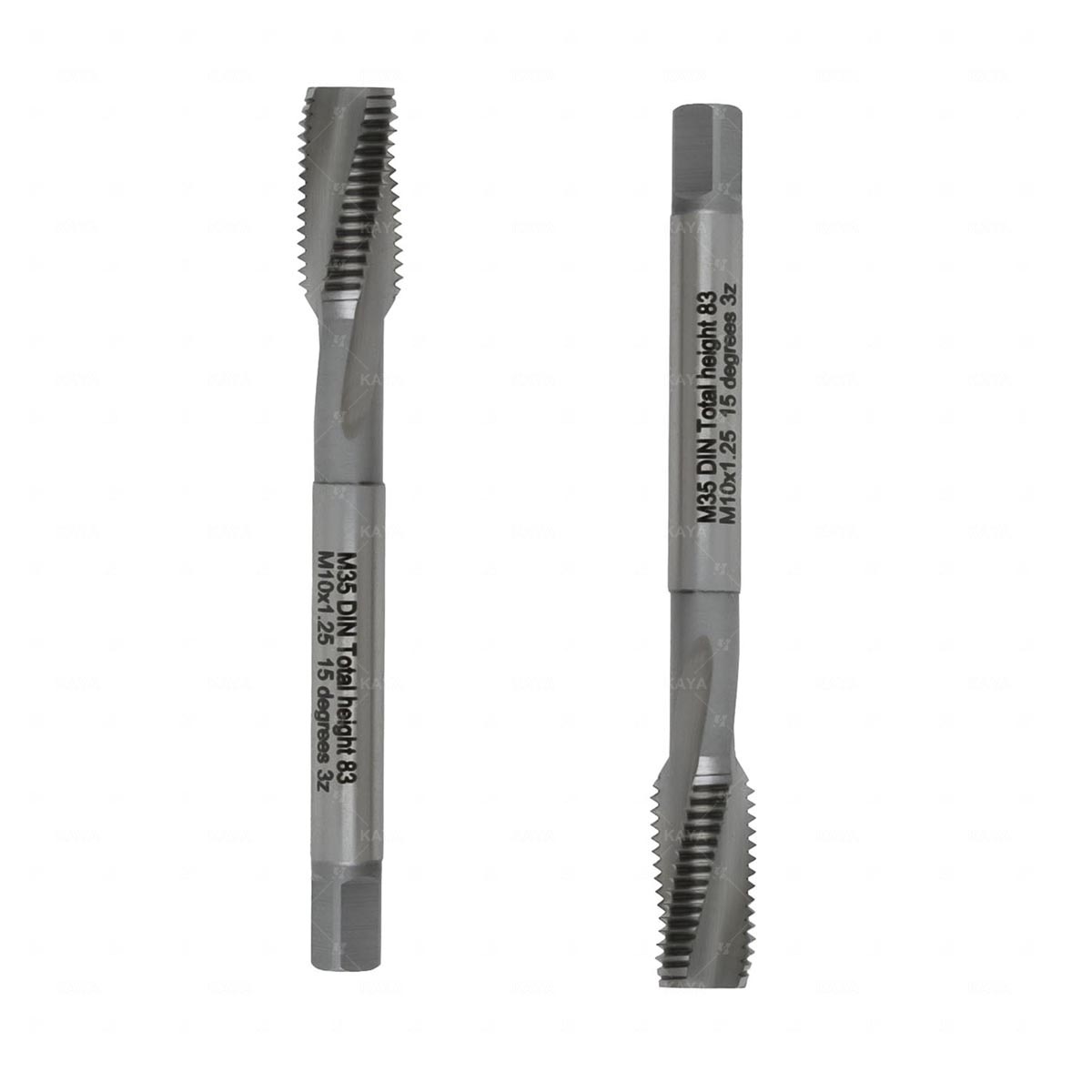
Why Are Broken Taps Always Found in Medical Device Factories’ Scrap Bins?
On an orthopedic screw production line, operators dread hearing a sharp "crack"—a sign that another stainless steel rod worth 500 RMB has been scrapped. When machining 316L medical-grade stainless steel with conventional taps, edge chipping typically occurs after every 80 threaded holes. Meanwhile, the medical industry demands a surface roughness of Ra 0.8μm, one-fifth the precision of a mirror finish.
The HSSE M35 tap, with its 8% cobalt content, provides distinct advantages:
- Anti-adhesion Coating: The TiCN surface coating reduces material adhesion by 40% when machining molybdenum-containing stainless steel (data from a German tooling laboratory).
- Advanced Chip-Breaking Groove: An asymmetric flute design optimized for 0.5–2mm micro-thread holes minimizes chip curl diameter to 0.3mm, effectively solving 95% of chip blockage issues in endoscopic components.
- Preheat Treatment Process: Special tempering ensures temperature fluctuation remains within ±15°C during continuous machining, preventing thermal deformation that could lead to thread diameter deviations.
Life-or-Death Speed in the Emergency Room Starts with Tooling
A North American medical device contract manufacturer once suffered delayed delivery of arthroscopic cannulas due to inconsistent tap tool life. After switching to M35 taps, they observed:
- Tool life when machining Ti-6Al-4V titanium alloy increased from 32 holes to 107 holes (under identical cooling conditions).
- Thread qualification rate surged from 88% to 99.3%, thanks to three key improvements:
- Micro-edge honing (0.02mm radius), reducing work hardening layer formation.
- Spiral flute angle adjustment from 30° to 42°, better suited to multi-directional stress structures in bone drills.
- Neck diameter reduced by 0.5mm, preventing friction against bore walls in sub-3mm microholes.

7 Irreplaceable Advantages of HSSE M35 Taps in Medical Device Manufacturing
The Ultimate Solution for Medical-Grade Stainless Steel
When machining 316L/317L medical stainless steel (hardness 180-200HB), the cobalt-vanadium-carbon alloy system of M35 taps achieves breakthroughs in:
- Chip control: The asymmetric chip-breaking groove ensures a chip curl radius ≤ 0.25mm (only 1/3 the diameter of a human hair), eliminating clogging issues in endoscopic cannula tapping.
- Anti-galling performance: TiCN coating reduces tool-material affinity by 62% (tested to ASTM G98), preventing cold welding when machining molybdenum-containing stainless steel.
- Extended tool life: When machining M1.6×0.35 orthopedic screws, a single M35 tap lasts 1,500 holes—four times longer than standard HSS taps.


Solving the Industry Challenge of "Thread Oxidation After Sterilization"
Medical devices undergo 134°C steam sterilization or ethylene oxide fumigation. The pre-oxidation treatment technology in M35 taps ensures:
- Formation of a 2–3μm dense oxide layer on titanium alloys, keeping post-sterilization thread surface roughness fluctuations ≤ Ra 0.2μm.
- Residual stress at thread roots reduced to below 120 MPa (X-ray diffraction tested), preventing stress corrosion cracking.
- When paired with sulfurized tapping fluid, sterilization residue detection pass rate improves from 87% to 99.6% (ISO 10993 biocompatibility standard).

Micron-Precision for Minimally Invasive Surgical Instruments
For ultra-precise instruments like neurosurgical electrodes and vascular intervention catheters:
- Stable deep-threading in micro-holes: Can machine 15:1 depth-to-diameter threads in 0.8mm bores (e.g., deep brain stimulation electrodes).
- ±0.002mm pitch accuracy, ensuring airtight sealing in pacemaker lead connectors.
- Vibration-free cutting: A custom spiral angle (42°±1°) keeps tapping vibration values below 0.05 mm/s² in sub-3mm holes.

Biocompatibility Safeguard for Implantable Devices
To meet stringent implant requirements:
- Zero heavy metal migration, FDA 21 CFR 182.90 certified, ensuring no cobalt ion release risk during machining.
- Surface integrity: When machining biodegradable magnesium alloy bone screws, thread subsurface damage remains <5μm (vs. 20μm with standard taps).
- Medical-grade lubrication compatibility: Supports residue-free machining with medical-grade white oils (e.g., Shell FM 68), reducing cleaning time by 40%.
Cross-Material Compatibility for Hybrid Medical Devices
Modern medical devices increasingly use titanium alloy + PEKK polymer composites. The M35 tap is optimized for:
- Thermal expansion compensation: When transitioning from titanium machining (600°C cutting temp.) to plastic cutting (80°C), tool thermal expansion deviation remains within 0.8μm/m•°C.
- Hardness adaptability: A single tap can successively cut HRC 38 titanium alloy and HRC 120 ceramic-coated substrates.
- Chip evacuation switching: Optimized flute volume gradient for metal vs. plastic chip formation (55° helix for metal, 30° for plastic).

"Emergency-Grade" Reliability Assurance
For rapid-response emergency device production:
- Plug-and-play tapping: Diameter tolerance compressed to h5, eliminating the need for machine retooling after tool changes.
- Tap failure warning: Laser-marked torque alert lines on the tool shank (Red: >3N•m; Yellow: 2–3N•m) allow operators to visually monitor wear.
- Catastrophic failure prevention: Core hardness gradient control (surface HV920 → core HV680) ensures the tap chips before catastrophic fracture.
End-to-End Cost Optimization
Beyond direct tool cost savings:
- 90% reduction in tapping fluid residue, cutting sterilization wash cycles from 3 to 1.
- Thread gauge pass rate stabilized at 99.5%, reducing QC workload from full to sample inspections.
- One M35 tap covers 85% of medical product needs, reducing SKU complexity by 60%.

The Future Battlefield: Micron & Molecular Precision Engineering
Micro-Threading in Neurosurgery
- Swiss manufacturer’s demand:
- 0.3mm ultrafine thread in a 1.5mm cobalt-chromium rod, 30mm deep, ±0.003mm pitch accuracy.
-
M35 solution:
- Dual-lead design: 3° front spiral for chip evacuation, 15° rear for rigidity.
- Laser-etched torque lines for wear monitoring.
Nano-Scale Precision for Future Biotech
- Ra 0.02μm surface finish (magnetorheological polishing).
- AlCrN/TiAlN nano-layer coating (3nm single-layer thickness) for biodegradable magnesium implants.
Conclusion
The "Capillary Revolution" of Medical Device Manufacturing
High-end taps do more than cut threads—they anticipate every life-or-death moment in real-world medical applications.
OEM Capability
 We like to do design according to all the customers' requirements, or offer them our new designs. With strong OEM/ODM capabilities, we can fill your sourcing demands.
We like to do design according to all the customers' requirements, or offer them our new designs. With strong OEM/ODM capabilities, we can fill your sourcing demands. Categories
| HSS-PM Taps | HSSE-M42 Taps |
| HSSE / HSS Taps | Spiral Flute Taps |
| Straight Flute Taps | Spiral Point Taps |
| Multi-function Taps |
| Solid Carbide Drill Bits | Twist Drill Bits |
| Center Drill Bits | Indexable U Drills |
| Flat-end Milling Cutter | Ball Nose End Mills |
